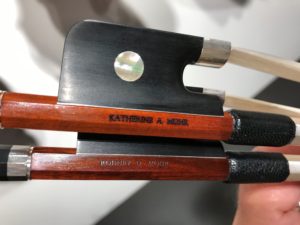This week’s discussion of the differences between bows will feel like a bit of a repeat of last weeks’ discussion of instruments. In the end, workmanship and material quality are two of the biggest differentiators when it comes to the cost and performance of a bow. Before we talk about quality differences, let’s go over a couple of ways we can group bows by stick material.
Fiberglass – many basic student bows have sticks made of fiberglass. This man-made material is relatively inexpensive, durable, and is readily available. The fiberglass stick bows we provide with our beginning rentals still utilize real horsehair for the hair of the bow and are an excellent choice for a beginning player. However, fiberglass is not suitable for a higher-quality bow.
Carbon fiber – this material is found in bows costing under $100 and over $8,000. While carbon fiber was seen in the past as a material suited for an advancing student or perhaps a professional’s backup bow, it is now in the hands of soloists on the world’s great concert stages.
Wood (not Pernambuco) – there are many types of wood used for bows besides Pernambuco. Brazilwood is a catchall term for different trees that are in the same family. Bow makers are experimenting with other woods such as Ipe in an attempt to ease the demand for Pernambuco.
Pernambuco – this Brazilian wood has been the preferred wood for bow making for centuries. The great French bow makers from the past and the top living makers prize this wood for its objective and subjective qualities. Because of this, it has been over harvested and top quality wood is now comparatively rare.
“Mountings” – the way the bow is “dressed”. This most commonly refers to the metal used for the hard parts of the bow, and is typically differentiated as nickel, silver, and gold. Over the years, bow makers have differentiated their finest work by using gold. As a result, a maker’s best Pernambuco is reserved for gold-mounted bows, and these works typically command the highest prices.
Ultimately, choosing the right bow for you goes beyond how it’s built or the material used – you need to spend time playing it on your instrument. One person’s dream bow can be a nightmare for another musician. We invite you to come and play the bows we carry in the shop!


Recent Comments